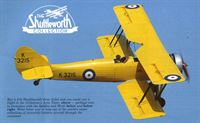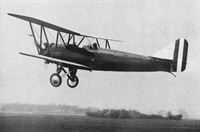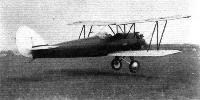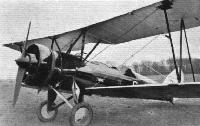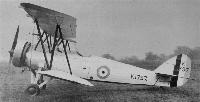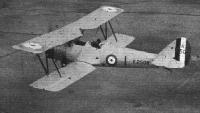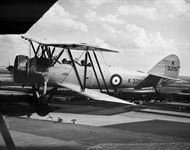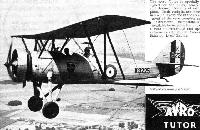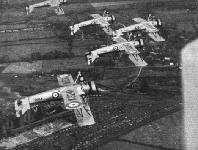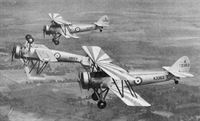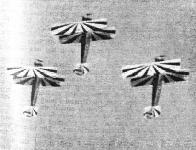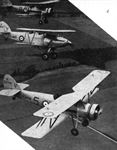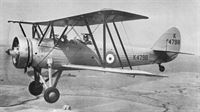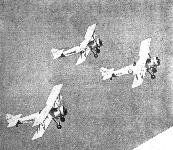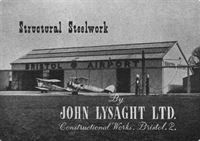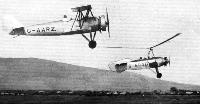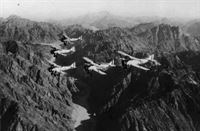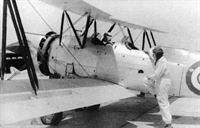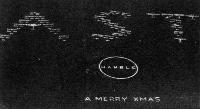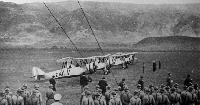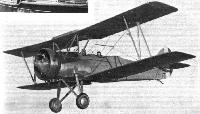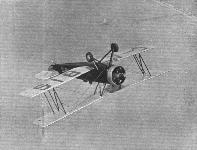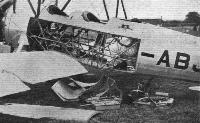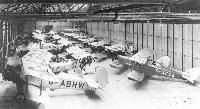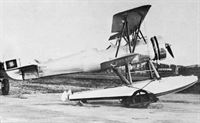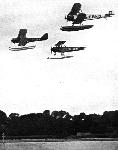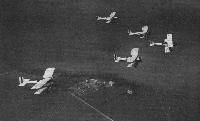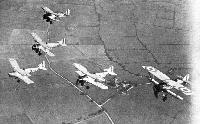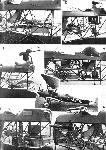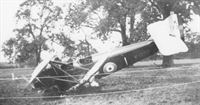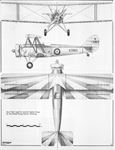
Описание
Страна : Великобритания
Год : 1929
Двухместный самолет первоначального обучения
Варианты
- Avro - Tutor/Sea Tutor/Prefect / Type 621/646/626 - 1929 - Великобритания
- Avro - Cadet / Type 631/643 - 1932 - Великобритания
- Avro - Club Cadet / Type 638/639/640 - 1933 - Великобритания
Avro 621 Tutor, Avro 646 Sea Tutor и Avro 626 Prefect
В начале 1930-х годов выявилась необходимость в замене основного самолета первоначального обучения британских ВВС Avro 504N. Его логичным преемником стал Avro 621 Tutor, спроектированный в 1929 году Роем Чедвиком. Каркас фюзеляжа равнокрылого биплана сварен из стальных труб и обтянут полотном. Самолет - двухместный, члены экипажа размещены тандемом в открытых кабинах. Прототип с гражданской регистрацией был оснащен звездообразным двигателем Armstrong Siddeley Mongoose IIIA. На сравнительные испытания самолет поступил в декабре 1929 года.
В 1930 году по результатам испытаний Avro 621 был выбран британскими ВВС, заказавшими установочную партию из 21 машины по спецификации 3/30 с открыто установленным 5-цилиндровым мотором Mongoose (как на прототипе), но почти все остальные серийные самолеты получили 7-цилиндровые двигатели Armstrong Siddeley Lynx IVC мощностью 240 л.с, закрытые узкими кольцами Тауненда. Некоторое количество самолетов построили и для гражданских заказчиков, а также на экспорт, в том числе для Ирландии, Канады и Китая.
Британские ВВС получили 394 из 795 построенных самолетов, серийный выпуск которых продолжался до мая 1936 года. Большинство самолетов строилось по спецификации 18/31, хотя в 1934-1936 годах некоторое количество двухпоплавковых гидропланов Avro 646 Sea Tutor собрали по спецификации 26/34, они прослужили до апреля 1938 года. Поставки серийных самолетов Tutor начались в 1933 году, и за короткий срок они стали основными учебными самолетами британских ВВС. Множество самолетов поступило в университетские эскадрильи и подразделения британских Вспомогательных ВВС. В конце 1930-х годов, с перевооружением частей первой линии британской авиации на самолеты-монопланы, потребовался также учебный самолет-моноплан. На смену Tutor пришли учебные монопланы Miles Magister. 57 самолетов Tutor собрали по лицензии в Южной Африке.
В 1930 году "Avro" изменила конструкцию планера машины, в большей степени приспособив ее под требования ВВС третьих стран. Новый вариант получил обозначение Avro 626 Prefect. Помимо первоначальной подготовки пилотов на этом самолете стало возможным обучать курсантов воздушной стрельбе, бомбометанию, навигации, ночным полетам, аэрофотографированию, радиосвязи и пр. Штатно экипаж самолета состоял из двух человек, но в задней кабине предусматривалась возможность размещения воздушного стрелка.
На Avro 626 поступило значительное количество заказов, и до прекращения серийного производства в 1939 году произвели 178 самолетов. Для британских ВВС самолеты поставлялись с января по июль 1935 года, а для Новой Зеландии - в июле. Самолеты Prefect заменили Avro 621 Tutor в навигационном училище, дислоцированном в Эндовере. Avro 626 выпускались либо с двигателями Armstrong Siddeley Lynx IVC мощностью 240 л. с, либо с моторами Armstrong Siddeley Cheetah V мощностью 260 л. с. Не менее трех самолетов с гражданской регистрацией пережили Вторую мировую войну.
Обозначение Avro 637 получили 8 самолетов, доработанных в патрульные по заказу Китая.
Варианты Avro
Avro 621 Tutor Mk II: один экземпляр с доработанными стойками бипланной коробки
PWS 18: обозначение 40 самолетов Tutor, построенных по лицензии польской фирмой PWS
ТАКТИКО-ТЕХНИЧЕСКИЕ ХАРАКТЕРИСТИКИ
Avro 621 Tutor
Тип: двухместный самолет первоначального обучения
Силовая установка: один звездообразный двигатель Armstrong Siddeley Lynx IVC мощностью 240 л. с. (179 кВт)
Характеристики: максимальная скорость на оптимальной высоте 196 км/ч; крейсерская скорость на высоте 305 м - 169 км/ч; скороподъемность на уровне моря 305 м/мин; практический потолок 4940 м; дальность полета 400 км
Масса: пустого 839 кг; максимальная взлетная 1115 кг
Размеры: размах крыла 10,36 м; длина 8,08 м; высота 2,92 м; площадь крыла 27,96 м2
Описание:
- Avro 621 Tutor, Avro 646 Sea Tutor и Avro 626 Prefect
- Flight, April 1930
THE "AVRO TRAINER" - Flight, June 1931
SPECIAL TYPES AT THE DISPLAY - Flight, November 1932
British Aircraft - Flight, November 1933
AVRO 637
Фотографии
-
Aeroplane Monthly 1977-03 / Avro Tutor /Preservation Profile/ (47)
Регистрационный номер: K3215 [12], G-AHSA [12]
-
Мировая Авиация 84
Этот Avro Tutor, служивший в Колледже британских ВВС в Кранвелле и в Центральной летной школе в 1930-х - начале 1940-х годов, стал последним из самолетов данного типа в британских ВВС. В составе коллекции он летает, начиная с 1959 года.
-
Aeroplane Monthly 1992-07 / D.Muscroft - Shuttleworth sunday
Регистрационный номер: K3215 [12], G-AHSA [12] Stuart Waring shows off the Shuttleworth Avro Tutor.
-
Aeroplane Monthly 1977-03 / Avro Tutor /Preservation Profile/ (47)
Регистрационный номер: K3215 [12], G-AHSA [12] The Shuttleworth Collection’s Avro Tutor.
-
Aeroplane Monthly 1993-02
Регистрационный номер: K3215 [12], G-AHSA [12] -
Aeroplane Monthly 1998-09 / M.Oakey, T.Harmsworth - Vintage news
Регистрационный номер: G-AHSA [12], K3215 [12] MIKE VINES of Photo Link was on hand with his camera at Old Warden on May 16, 1998 for the first Sunset Flying Display of the season. Avro Tutor K3215/G-AHSA.
-
Aeroplane Monthly 1993-05 / S.Harding - RNZAF Historic Flight
Регистрационный номер: NZ203 [10], ZK-APC [10] Avro 626 NZ203 shows off its classic lines over South Island, New Zealand, soon after the creation of the Historic Flight in 1985. Although still flyable, the aircraft is on long-term static display at the RNZAF Museum.
-
Aeroplane Monthly 1993-05 / S.Harding - RNZAF Historic Flight
Регистрационный номер: NZ203 [10], ZK-APC [10] The Avro 626 returns to Wigram at the conclusion of an early training sortie.
-
Air International 1987-07 / Talkback
Регистрационный номер: NZ203 [10], ZK-APC [10] Другие самолёты на фотографии: De Havilland Tiger Moth / D.H.82 - Великобритания - 1931North American T-6 Texan / AT-6 Harvard - США - 1935
-
Aeroplane Monthly 1979-03 / G.Jenks - Avro 621 Tutor /RAF Piston Trainers/ (4)
Регистрационный номер: K-4 The second prototype 621, with B conditions marking K-4 and fitted with standard elliptical tail unit and 240 h.p. Lynx engine.
-
Flight 1930-11 / Flight
Avro Trainer school machine. (Lynx engine.)
-
Flight 1930-05 / Flight
THE "AVRO TRAINER": Three-quarter Front View. The Fabric Fairings are made as detachable units to facilitate inspection of the Fuselage Structure.
-
Flight 1930-05 / Flight
The Nose of the "Avro Trainer" fitted with "Mongoose" engine.
-
Flight 1931-07 / Flight
FOR USE IN COLD CLIMATES: A new type of cowling has been produced by the Avro company for their Trainer (621) and Advanced Trainer (626) machines. The openings in the cowling can be adjusted from the cockpit by a Bowden cable and plunger arrangement.
-
Flight 1930-05 / Flight
An alternative power plant. The "Avro Trainer" fitted with "Lynx" engine.
-
Flight 1930-05 / Flight
THE "AVRO TRAINER": The front view gives a good idea of the wide track of the undercarriage.
-
Air Enthusiast 1996-05 / R.Bonser - Hamble Pictorial. Air Service Training in the 1930s
Регистрационный номер: G-ABIR [3], HM504 [3] Avro 621 Tutor G-ABIR. This Tutor served from March 1931 until being impressed as HM504 in October 1941 with 3 EFTS, as the school had become. In April 1942 it was downgraded to instructional airframe status, becoming 3065M.
-
Авиация и Космонавтика 2010-06 / Ю.Кузьмин - Сталь в авиации: кто был первым? /Из истории авиации/
Типичный самолет конца 1920-х годов: каркас фюзеляжа, крыла и оперения - стальные трубы, обшивка полотняная. На фотографии прототип самолета Avro 621 Tutor с мотором Mongoose, 1929г.
-
Flight 1930-11 / Flight
Регистрационный номер: K1230 [3] Avro Trainer school machine. Armstrong-Siddeley Mongoose engine.
-
Flight 1930-05 / Flight
THE "AVRO TRAINER": In this three-quarter rear view, possibility of jumping by parachute from either cockpit is well brought out.
-
Flight 1932-05 / Flight
A MODERN TRAINING MACHINE: The Avro "Tutor," or 621, with Armstrong-Siddeley "Lynx" engine, is a worthy successor of the 504.
-
Flight 1930-06 / Flight
THE AVRO "TRAINER": Designed to supplant the famous Avro-Lynx, this machine is of all-metal construction, and incorporates all possible modern refinements. Supplied either with "Mongoose" or "Lynx" engines.
-
Aeroplane Monthly 1979-03 / G.Jenks - Avro 621 Tutor /RAF Piston Trainers/ (4)
An early production Avro 621, with Mongoose engine and early Avian type tail unit, for the Irish Air Corps.
-
Flight 1930-05 / Flight
THE "AVRO TRAINER": The machine in flight.
-
Flight 1930-05 / Flight
The "Avro Trainer" in flight at Woodford Aerodrome.
-
Flight 1930-04 / Flight
NEW ALL-METAL TRAINING MACHINE: After undergoing tests at Martlesham, the new Avro "Trainer" has now gone into production, and a batch of machines is being built. Several have also been ordered for use in the Dominions and abroad, some for air survey work. The machine can be fitted with the Armstrong-Siddeley "Mongoose" engine (standard) or with the "Lynx" for special purposes, such as operating from aerodromes situated at a considerable altitude. A detailed description will be published next week.
-
Aeroplane Monthly 1979-03 / G.Jenks - Avro 621 Tutor /RAF Piston Trainers/ (4)
Регистрационный номер: K1230 [3] The first production Avro 621 with pupil under the blind flying hood. The first 621s had Avian-type tail units, large faired shock absorbers on the undercarriage, and were powered by uncowled 155 h.p. Mongoose IIIA radial engines.
-
Air Enthusiast 1996-05 / R.Bonser - Hamble Pictorial. Air Service Training in the 1930s
Регистрационный номер: G-ABIR [3], HM504 [3] Avro 621 Tutor G-ABIR is flight over the school buildings with the AST hangar just behind the tail and the northern airfield above its upper wing. This Tutor served from March 1931 until being impressed as HM504 in October 1941 with 3 EFTS, as the school had become. In April 1942 it was downgraded to instructional airframe status, becoming 3065M.
-
Flight 1932-03 / Flight
Регистрационный номер: G-ABGG FOR GUNNERY INSTRUCTION: An aerial view of one of the Avro 626 Advanced Training aeroplanes, showing the machine fitted up for instruction in observers' gunnery.
-
Flight 1933-08 / Flight
Регистрационный номер: K2508 [2] INSTRUMENT FLYING: The pupil is under the hood in the rear cockpit.
-
Flight 1931-12 / Flight
Регистрационный номер: K2496 [2] AVROS FOR THE AIR MINISTRY: The first eight of a batch of Avro Lynx Tutor type 621 training biplanes supplied recently to the Air Ministry.
-
Flight 1930-07 / Flight
MEMBERS OF THE AVRO FAMILY: Beginning with the machine in the foreground, the types lined up are: The "Avian Monoplane," the "Avian" biplane, the "Avro Trainer," the Avro Five and the Avro Six.
Другие самолёты на фотографии: Avro Avian / Type 594/616 - Великобритания - 1926Avro Avian Monoplane / Type 625 - Великобритания - 1930Avro Five / Type 619 / Six / Type 624 - Великобритания - 1929
-
Flight 1932-11 / Flight
THE AVRO 626: A training type used for flying training and military training (gunnery, bombing, photography, radio, etc.).
-
Flight 1931-03 / Flight
BRITISH AIRCRAFT TYPES WHICH ARE BEING FLOWN AT EL PALOMAR: 3, Avro Advanced Trainer, type 626, Armstrong-Siddeley "Lynx" engine.
-
Jane's All the World Aircraft 1938 / 03 - All the world's aeroplanes
Регистрационный номер: K1797 The Avro "Tutor" Two-seat Training Biplane (215 h.p. Armstrong Siddeley "Lynx" engine).
-
Flight 1933-07 / Flight Advertisements
Регистрационный номер: K3196 Avro Tutor. Lynx Engine. The success with which the Avro Tutor completed three years of official trials in competition with every other British training aeroplane has been confirmed by the selection of the Tutor by the British Air Ministry as the new standard training aeroplane of the Royal Air Force.
-
Aeroplane Monthly 1986-05 / Personal album
Регистрационный номер: K3213 Avro Tutor K3213 spent most of its flying life at the RAF College. In May 1938 it was grounded and given the serial number 1063M.
-
Aeroplane Monthly 1977-03 / Avro Tutor /Preservation Profile/ (47)
Регистрационный номер: K3215 [12], G-AHSA [12] In service during the ’30s. Note tail skid and lack of aileron tie rod
-
Aeroplane Monthly 1977-03 / Avro Tutor /Preservation Profile/ (47)
Регистрационный номер: K3215 [12], G-AHSA [12] On a photographic sortie from Old Warden in 1972
-
Aeroplane Monthly 1979-03 / G.Jenks - Avro 621 Tutor /RAF Piston Trainers/ (4)
Регистрационный номер: K3215 [12], G-AHSA [12] The Shuttleworth Collection’s Tutor near its home at Old Warden, Bedfordshire.
-
Jane's All the World Aircraft 1980 / Encyclopedia of Aviation - Aircraft A-Z - v2
Регистрационный номер: K3215 [12], G-AHSA [12] Avro 621 Tutor.
-
Air-Britain Archive 1986-02
Регистрационный номер: K3215 [12], G-AHSA [12] Avro Tutor G-AHSA in original identity as K3215 performing at an Old Warden display in April 1971.
-
Flight 1935-05 / Flight
Регистрационный номер: K3225 [3] THE CHIEF INSTRUCTOR: Sqd. Ldr. Chick in an Avro "Tutor."
-
Flight 1936-07 / Flight Advertisements
Регистрационный номер: K3225 [3] The Avro "Tutor" (215 h.p. "Lynx") is the standard training type in the Royal Air Force.
-
Flight 1936-06 / Flight Advertisements
Регистрационный номер: K3225 [3] -
Flight 1933-07 / Flight Advertisements
Регистрационный номер: K3238 [4], K3239 [4], K3240 [4], K3241 [4], K3242 [4] Avro Tutors (Lynx) in Formation.
-
Aeroplane Monthly 1990-06 / J.Meadows - Flying for fun (1)
Регистрационный номер: K3238 [4], K3239 [4], K3240 [4], K3241 [4], K3242 [4] Five Central Flying School Avro Tutors with red-and-white sunbursts on their top surfaces. This team spent as much time flying inverted as it did the right way up.
-
Flight 1935-06 / Flight Advertisements
Регистрационный номер: K3238 [4], K3239 [4], K3240 [4], K3241 [4], K3242 [4] -
Flight 1937-05 / Flight
Регистрационный номер: K3238 [4], K3239 [4], K3240 [4], K3241 [4], K3242 [4] Thanks very largely to the Avro concern the R.A.F. has always had first-class trainers. Tutors are seen here rehearsing inverted flying for an R.A.F. display.
-
Aeroplane Monthly 1979-03 / G.Jenks - Avro 621 Tutor /RAF Piston Trainers/ (4)
Регистрационный номер: K3261 Avro 621 Tutor K3261 of the Central Flying School, one of the first recipients of the type
-
Flight 1937-08 / Flight
Регистрационный номер: K3274 Members of the C.U.A.S. and their instructors. Second from the left is the Chief Instructor, Wing Cdr. Lockyer, and fourth is the C.F.I., Sqn. Ldr. Mason.
-
Aeroplane Monthly 1979-03 / G.Jenks - Avro 621 Tutor /RAF Piston Trainers/ (4)
Регистрационный номер: K3363 [4], K3364 [4], K3365 [4] The modern successor of the 504: Three Avro Tutors from the Central Flying School in formation, with the leader flying inverted.
Three Central Flying School Avro 621s, K3363, K3364 (inverted) and K3365, flying from Upavon in June 1937. -
Air Pictorial 1969-06 / P.March - Central Flying School
Регистрационный номер: K3363 [4], K3364 [4], K3365 [4] Flashback to 1933 - C.F.S. aerobatic team on Avro Tutors
-
Flight 1937-07 / Flight
Регистрационный номер: K3363 [4], K3364 [4], K3365 [4] Tens of thousands saw from below these three Tutors from the Central Flying School. In this view of them, taken at their own level, the attitudes of the machines are more clearly brought out. Note that in the inverted position the leader's machine has to be at a much greater angle to obtain the necessary lift.
-
Flight 1935-06 / Flight
Регистрационный номер: K3363 [4], K3364 [4], K3365 [4] A TUTORIAL TRICK. Instructors from The Central Flying School, Wittering, in special "Tutors," rehearse a phase of their inverted flying act to be given at Hendon on June 20. The rearmost machines, of course, are not in their normal attitude...
-
Flight 1933-07 / Flight
THE TOP SILVER SIDE: Three "Tutors" from C.F.S.
-
Flight 1934-06 / Flight
COULD PEGOUD HAVE FORESEEN THIS? Before he made the first loop, it is said that the French pilot Pegoud had himself strapped upside down to a bench to grow accustomed to the sensation. These instructors of the Central Flying School at Wittering seem quite at home in their inverted Avro "Tutors," in which they will perform at the R.A.F. Display.
-
Flight 1935-07 / Flight
INVERSION AT CLOSE QUARTERS. Something the Hendon Display spectators did not see - what the inverted Ano "Tutors" of the Central Flying School look like from another machine only a few yards distant.
Avro Tutors of the Central Flying School, Wittering, rehearsing their display of inverted flying for the 1933 RAF Display at Hendon. -
Aeroplane Monthly 1976-10 / Personal album
Регистрационный номер: K3311, K3387 [2] The Avro 621 Tutor is wearing the dual identity K3387 and K3311, a common occurrence with training aircraft when parts were often interchanged. This Tutor was a 610 Squadron aircraft and is seen at Hooton. Note the blind flying hood folded down behind the rear cockpit.
-
Aeroplane Monthly 1979-03 / G.Jenks - Avro 621 Tutor /RAF Piston Trainers/ (4)
Регистрационный номер: K3387 [2] Two 621s of No 610 Squadron at Hooton Park in 1938,
-
Flight 1936-07 / Flight
Регистрационный номер: K3453 Ready for the afternoon's work. The Tutors are lined up and instructors ani members are just going up for solo or dual flights.
-
Aeroplane Monthly 1977-08
Регистрационный номер: K3473 London University in the air: "echelon stepped up" by the U.L.A.S. in their Tutors.
The Avro Tutors of the University of London Air Squadron were captured by Flight’s photographer during the unit's annual camp, at Halton, in July 1937. -
Flight 1938-07 / Flight
Регистрационный номер: K3474 Tutors and a Hart Trainer of the U.L.A.S. in echelon formation. The University arms are painted on the fins, while the horizontal band on the fuselage of the Tutors is purple, the sporting colour of London University.
Другие самолёты на фотографии: Hawker Hart - Великобритания - 1928
-
Aeroplane Monthly 1979-03 / G.Jenks - Avro 621 Tutor /RAF Piston Trainers/ (4)
Регистрационный номер: K4798 [4] Oxford University Air Squadron Avro 621 Tutor K4798 over the Eastchurch area in July 1935.
-
Flight 1935-08 / Flight
Регистрационный номер: K4798 [4] INSTRUCTOR AND PUPIL: An Avro "Tutor" of the Oxford University Air Squadron flying along the Kentisn coast, with Whitstable in the background.
AVRO TUTOR: Trainer (Lynx IVC engine - 240 h.p. at sea level); span, 34ft.; gross weight, 2,458 lb.; max. speed, 122 m.p.h. -
Aeroplane Monthly 1993-03 / J.Maynard - Cheshire VC (1)
Регистрационный номер: K3444 [2], K4798 [4], K4820 [2] A flight of three "Tutors" of Oxford University Air Squadron off the coast of Kent. The convoy of barges has just emerged from the so-called river Swale, which separates the Isle of Sheppey from the mainland.
Oxford University Air Squadron Avro Tutors off Eastchurch on July 26, 1935 during summer camp on the Isle of Sheppey. -
Flight 1936-07 / Flight Advertisements
Регистрационный номер: K3444 [2], K4798 [4], K4820 [2] -
Flight 1935-06 / Flight
Регистрационный номер: K5063 SCHOLASTIC. This special version of the Avro "Tutor" (215 h.p. "Lynx") built for Royal Air Force use, and known officially as the "Prefect," is to be used initially for navigational training; a number are on order. Increased tankage appears to be a feature.
-
Мировая Авиация 40
Регистрационный номер: K6100 Tutor установочной партии, заказанной британскими ВВС. Один самолет Tutor в 1948 году прошел модернизацию и использовался менеджером фирмы "Avro" в качестве персонального транспорта.
-
Flight 1940-09 / Flight Advertisements
Другие самолёты на фотографии: De Havilland Moth Major / D.H.60GIII - Великобритания - 1932
-
Flight 1934-06 / Flight
AN INTERNATIONAL GATHERING: A view along the machine park at Vincennes. The Avro "Tutor" of the ill-fated Portuguese competitor is in the foreground.
-
Aeroplane Monthly 1994-02 / B.Elliott - Above, the law (1)
Redhill Aerodrome on August 3, 1935, the day of the launching of the Reigate Borough Special Constabulary. In this line-up are four Redhill Flying Club D.H.60 Moths (including G-AAJZ), a Fox Moth, Avro Tutor and Puss Moth G-ABSO in the background.
Другие самолёты на фотографии: De Havilland Fox Moth / D.H.83 - Великобритания - 1932De Havilland Gipsy Moth / Moth X - Великобритания - 1928De Havilland Puss Moth / D.H.80 - Великобритания - 1929
-
Air Enthusiast 2001-01 / R.Stitt - Midland Memories (1)
Регистрационный номер: G-AHSA [12], K3215 [12] Avro Tutor G-AHSA is run-up at Burnaston by Chief Flying Instructor Ron De'Ath prior to its CoA test flight on June 6, 1953; maintenance engineer Tony Topps occupies the rear seat. In the background is the former gatehouse to Burnaston House, the home of Derby Aviation's chief pilot, Eric Lines
-
Aeroplane Monthly 1977-03 / Avro Tutor /Preservation Profile/ (47)
Регистрационный номер: G-AHSA [12], K3215 [12] At the Goodyear Trophy Race, Wolverhampton, May 17, 1952
-
Aeroplane Monthly 1989-03 / Personal album. Civil
Регистрационный номер: G-AHVO, K5066 Avro 626 G-AVHO, formerly K5066 in the RAF, was civilianised in 1946 and registered on July 9. When this photograph was taken it was owned by A. G. Harding of Hastings. It was scrapped at Hastings in 1950.
-
Flight 1932-12 / Flight
Регистрационный номер: G-AARZ The Avro 621 "Tutor" and the Autogiro of Sir Alan's Circus flying in typical Cape Town scenery.
Другие самолёты на фотографии: Cierva/Avro C.19 - Великобритания - 1929
-
Flight 1935-04 / Flight
Регистрационный номер: G-ABZP [2] Flt Lt Geoffrey Tyson surveys a sea of upturned faces from his inverted Lynx-engined Avro Tutor G-ABZP at Redhill on April 13, 1935.
Другие самолёты на фотографии: Goppingen Go.1 Wolf - Германия - 1935
-
Flight 1933-08 / Flight Advertisements
Регистрационный номер: G-ABRK THE AVRO '626' CHEETAH OR LYNX ENGINE for ab initio and entire transformation instruction. The small air force can, moreover, use the Avro '626' for many peace-time military purposes with economy and without loss of efficiency
-
Aeroplane Monthly 1981-04 / V.Hodgkinson - Abinitio at Point Cook
Регистрационный номер: A6-17 Avro Tutor A6-17 from Point Cook. RAAF Tutors had tailwheels and inverted fuel systems.
-
Air-Britain Archive 1982-04
D.H.60 Moths, Avro Tutors and Westland Wapitis of the Cadet Training Unit, Point Cook, 1939.
A line-up of RAAF Moths during the thirties with A7-61 (c/n 1354) prominent in the foreground ahead of A7-71.Другие самолёты на фотографии: De Havilland Gipsy Moth / Moth X - Великобритания - 1928Westland Wapiti - Великобритания - 1927
-
Air Pictorial 1958-01
Регистрационный номер: ZK-APC [10], NZ203 [10] Old Avro. Formerly NZ203, ZK-APC is the last of the prewar R.N.Z.A.F. Avro 626s. Owned by J. Frogley, it still flies at Christchurch, New Zealand.
-
Aeroplane Monthly 1993-05 / S.Harding - RNZAF Historic Flight
Регистрационный номер: ZK-APC [10], NZ203 [10] The Prefect NZ203 as a civil aircraft under the registration ZK-APC from 1947 to 1958 (to 1965 ???).
-
Aeroplane Monthly 1985-10 / ??? - Preserved Prefect
Регистрационный номер: NZ203 [10], ZK-APC [10] The photograph was taken while NZ203 was serving on general tasks at RNZAF Ohakea during World War Two.
-
Aeroplane Monthly 1985-10 / ??? - Preserved Prefect
Регистрационный номер: NZ203 [10], ZK-APC [10] -
Aeroplane Monthly 1985-09 / Grapevine
Регистрационный номер: NZ203 [10], ZK-APC [10] Avro 626 NZ203 on its first post-restoration flight, at Ohakea on July 8, 1985.
-
Aeroplane Monthly 1985-10 / ??? - Preserved Prefect
Регистрационный номер: NZ203 [10], ZK-APC [10] NZ203 on the day of its first post-restoration flight at Ohakea, on July 8, 1985. The aircraft was airborne for just under half an hour and, said pilot Lanham, “She handled just like a big docile Tiger" - the type which superseded the Avro in RNZAF service.
-
Air-Britain Aeromilitaria 1983-01
Регистрационный номер: J208, J223, J229, J309, J312 A formation of Avro 626 three-seaters of the REAF flying near Almaza. J208 and J223 have gunrings fitted, J309 and J229 have open third cockpits and J312 has its third cockpit faired over by a flat plate.
-
Air-Britain Aeromilitaria 1984-03
Proof that Egypt is not all sand is given by the background to the formation of five Avro 626s over Sinai
-
Flight 1936-02 / Flight Advertisements
Регистрационный номер: J322, J323, J326 Ten 626s to supplement those already in service with the Egyptian Army Air Force
-
Flight 1935-02 / Flight Advertisements
Регистрационный номер: J321, J328 -
Flight 1933-11 / Flight
Регистрационный номер: J305 FOR EGYPT: This Avro 626 (Armstrong-Siddeley "Cheetah") is one of the batch of machines which have been sold through Airwork, Ltd., to the Egyptian Government for training and general reconnaissance work in Egypt. They are being taken over by Government representatives at Lympne Aerodrome shortly, where a number of Egyptian officers are undergoing training.
-
Air-Britain Aeromilitaria 1983-01
Регистрационный номер: J302 [3], J304 [2] Eight of the first batch of Avro 626s lined up prior to departure from the United Kingdom
-
Flight 1933-12 / Flight Advertisements
Регистрационный номер: J302 [3], J304 [2], J306 AVRO 626's supplied to the EGYPTIAN ARMY AIR FORCE
-
Flight 1935-06 / Flight Advertisements
The Avro 626 machines illustrated form part of a recent order for the Egyptian Army Air Force.
-
Flight 1933-12 / Flight Advertisements
Регистрационный номер: J302 [3] A BATCH OF AVRO 626 BIPLANES FITTED WITH CHEETAH ENGINES WHICH ARE TO BE USED BY THE EGYPTIAN AIR FORCE FOR DESERT PATROL WORK
-
Air-Britain Aeromilitaria 1983-01
Close-up of the Avro 626 cockpits
-
Flight 1933-11 / Flight
THE INSPECTION: The Egyptian Minister and Kaimakam Tait Bey inspecting the pilots under Bimbashi Webster.
-
Flight 1933-11 / Flight
THE FLIGHT INTO EGYPT: The new equipment of the Egyptian Army Air Force.
-
Flight 1934-09 / Flight
The Egyptian party, with Kaimakam Tait Bey and Bimbashi Webster, inspects the personnel.
-
Aeroplane Monthly 1990-10 / J.Meadows - Flying for fun (5)
RAF Upavon aerodrome in June 1938 at the time when it abounded with Ansons, Oxfords, Harts, Tutors and Furies.
Другие самолёты на фотографии: Airspeed Oxford / AS.10 - Великобритания - 1937Hawker Fury - Великобритания - 1931Hawker Hart - Великобритания - 1928
-
Air-Britain Archive 1986-01
Регистрационный номер: G-ABZP [2] Yeadon on the occasion of the last National Aviation Display visit 14/15th September 1935. On the concrete apron are Moth G-AAJW and Puss Moth G-ABKG. The house on the right, below the apron, was multi-purpose with the manager's accommodation, club house and, in the annex, the passenger 'terminal'. Arrow Aircraft's factory was later built where the tents can be seen lower left. Visiting aircraft include from the bottom Avro 504N G-ADBD, Cadets G-ACOZ, G-ACPB, G-ACLU, Wessex G-EBXK, Tutor G-ABZP, a glider and a Dragon Rapide.
Другие самолёты на фотографии: Avro Avro 504N - Великобритания - 1920Avro Club Cadet / Type 638/639/640 - Великобритания - 1933De Havilland Dragon Rapide / Dominie / D.H.89 - Великобритания - 1934De Havilland Gipsy Moth / Moth X - Великобритания - 1928De Havilland Puss Moth / D.H.80 - Великобритания - 1929Westland Wessex / Westland IV - Великобритания - 1929
-
Flight 1934-11 / Flight
TUNIS: An aerial view of Tunis Aerodrome. In addition to the French military aeroplanes on the ground, the squadron of Avro 626 aircraft which recently flew out to Egypt from England, are also shown in this picture. Incidentally, these Egyptian machines reached Cairo on October 1.
-
Flight 1936-12 / Flight
APPOSITE: Christmas greetings from Air Service Training Ltd. at Hamble. The message is formed by white-overalled humanity "on the hands down," and the "A.S.T." consists of the ten different aircraft types which form the organisation's fleet: Avro V, 626, Avian, Tutors and Cadets; two-seater Siskin; A.W. Atlas; two Cutty Sarks; and D.H. Leopard Moth and Hornet Moth.
Другие самолёты на фотографии: Armstrong Whitworth Atlas / Ajax - Великобритания - 1925Armstrong Whitworth Siskin - Великобритания - 1921Avro Avian / Type 594/616 - Великобритания - 1926Avro Cadet / Type 631/643 - Великобритания - 1932Avro Five / Type 619 / Six / Type 624 - Великобритания - 1929De Havilland Hornet Moth / D.H.87 - Великобритания - 1934De Havilland Leopard Moth / D.H.85 - Великобритания - 1933Saunders-Roe Cutty Sark / A.17 - Великобритания - 1929
-
Jane's All the World Aircraft 1938 / 02 - The progress of the world in military aviation during the year 1937-38
Avro "Tutor" Training Machines of the Greek Air Force at Janina.
-
Flight 1937-12 / Flight
FOR PORTUGUESE INSTRUCTION: Part of a batch of Avro 626 comprehensive military trainers (Siddeley Cheetah V) at Avro's Woodford aerodrome prior to delivery to the Portuguese Government. Despite the fact that the 626 was designed some years ago it is still extremely popular.
-
Air International 1997-01 / B.Butt - Ready to Serve. Hong Kong's Government Flying Service
Three Avro Tutors were used for ab initio training of cadet pilots in 1936.
-
Flight 1933-07 / Flight Advertisements
Avro 626. Cheetah or Lynx Engine. For the entire instruction of pilots and observers. For each alternative duty, standard service armament and equipment is used and in all cases both pilot instructor and pupil are accomodated.
-
История Авиации 31 / В.Морозов - Авиация Эстонии /Наши соседи/ (1)
Следом за "французской эрой" в авиации Эстонии наступила "английская". На снимке "Авро-626"
-
Авиация и Космонавтика 2018-02 / В.Морозов - Авиация Литвы: 1919-2018гг. (2)
Один из трех учебных Авро-626 ВВС Литвы. Каунас, 1937 г.
-
Flight 1937-06 / Flight Advertisements
The Avro 626 Trainer is readily adaptable for every branch of flying instruction. The photograph shows one of a number of these trainers recently supplied to the Brazil government. Avro training machines are now used by eighteen foreign governments.
-
Flight 1937-02 / Flight
The Avro 626 Training Biplane (277 h.p. Armstrong Siddeley "Cheetah V" engine) as supplied to the Brazillian Government.
An Avro 626 (275 h.p. Armstrong Siddeley Cheetah V) trainer for Brazil. It can be used for a variety of purposes, the rear cockpit being adaptable for gunnery, prone bombing, photography or radio, while provision is made for instrument flying and message collection. In the front seat is Mr. H. A. Brown (Avro chief test pilot), and the passenger is Sefior Polzin, Brazilian Vice-Consul. -
Flight 1937-07 / Flight Advertisements
The Avro 626 Trainer provides for the complete training of all flying personnel, and has proved economical both in cost and operation. The photograph shows one of a number of these trainers recently supplied to the Brazilian government. Avro training aircraft are now used by eighteen foreign governments.
-
Flight 1934-05 / Flight
Регистрационный номер: G-ABIS [3], HM505 [3] INVERSION: An Avro Tutor from A.S.T. over Southampton Water. The attitude of the sailing vessel is sufficient proof that the picture itself has not been inverted!
-
Flight 1936-03 / Flight Advertisements
Регистрационный номер: G-ABIS [3], HM505 [3] -
Flight 1937-11 / Flight
The Lynx-engined Avro Tutor trainer is seen here as a single-seater specially equipped for inverted flying. It is normally a dual-control two-seater.
-
Flight 1939-05 / Flight
Avro Tutors (still extremely popular, though some years old) rehearsing for an Empire Air Day “crazy flying” event at Northolt.
-
Flight 1935-08 / Flight
FROM ISIS TO SWALE: The Oxford University Air Squadron is now encamped at Eastchurch in the isle ol Sheppey, and its Avro "Tutors" range over the waters of the Thames estuary. Here a flight is seen over a line of red-sailed barges which have just emerged from the Swale channel.
-
Flight 1934-07 / Flight
OXFORD UNIVERSITY AIR SQUADRON: A formation of "Tutors" over Canterbury. The squadron is doing its annual training at Eastchurch.
-
Flight 1934-07 / Flight
IN FORMATION: The Cambridge University Air Squadron on Avro "Tutors" over Salisbury Plain.
-
Flight 1935-08 / Flight
Whitstable as seen from the air, with a flight of the Oxford "Tutors" coasting along.
-
Flight 1938-07 / Flight
Pupils, instructors, and Tutors of the U.L.A.S. The C.F.I., Wing Cdr. Hammersley, M.C., is making his spaniel beg. Just behind him, in white, is the adjutant, Flt. Lt. J. Grandy, while on his right, with a long row of medal ribbons, is the Chief Instructor, Wing Cdr. T. F. W. Thompson, D.F.C.
-
Flight 1935-01 / Flight
CHILE! This Avro 626 (Siddeley "Cheetah") training machine was flown over the Andes in mid-winter by Mr. H. A. Brown, the makers' chief test pilot, accompanied by his engineer, Mr. Harper. It was necessary to cross the range at 18,000 ft., and the machine was loaded to a gross weight of 3,250 lb. The "626" was the first of its type to be delivered to the Chilean Air Force. This group, taken at Santiago de Chile, shows (left to right) Senor Paul Besa, Commodoro Franki, Commodoro Don Diego Aracena (Chief of the Chilean Air Force), Mr. Brown and Commandante Castro.
-
Flight 1937-07 / Flight
RIGHT WAY UP! During a recent visit to the C.F.S., Flight's photographer inveigled these three pilots into a "close-up." Since the Hendon Display crowd almost saw their faces as they flew their Avro Tutors inverted at low altitude, we make no apology for departing from the Hendon "no limelight" convention. Left to right : Flt. Lts. Mermagen and Stephenson and Flt. Sergt. Scragg.
-
Flight 1934-01 / Flight
ADVANCED TRAINING: Mr. A. V. Harvey and two Chinese pilots with an Avro 626 ("Lynx").
-
Flight 1934-01 / Flight
THE AVRO 626 ("LYNX"): Flt. Lt. Pope and his passenger just before the start of the Speed Race.
-
Flight 1938-06 / Flight
An Avro Tutor loaded with eager humanity at Kenley.
-
Flight 1932-11 / Flight
LORD LONDONDERRY: Secretary of State for Air arriving in an Avro "Trainer."
-
Flight 1934-08 / Flight
NOT AN ACCIDENT: The Avro 626 is variously used for training in gunnery, bombing, photography and wireless.
-
Flight 1934-07 / Flight
AVROS AT THE S.B.A.C. DISPLAY: From front to back, the "Cadet," the Autogiro, the "Commodore," the 626, and the 642.
Другие самолёты на фотографии: Avro Cadet / Type 631/643 - Великобритания - 1932Avro Commodore / Type 641 - Великобритания - 1934Avro Type 642 - Великобритания - 1933Cierva/Avro C.30A / Rota - Великобритания - 1932
-
Flight 1937-12 / Flight
NATIONS AT THE FOUNTAIN: A Yugoslav Autogiro (Genet Major), a Portuguese 626 comprehensive trainer Cheetah) and an Irish Anson reconnaissance machine (two Cheetahs) in a "feeding time" scene at Woodford, Avro's Manchester aerodrome. The Anson is fitted with flaps.
Другие самолёты на фотографии: Avro Anson / Type 652 - Великобритания - 1935Cierva/Avro C.30A / Rota - Великобритания - 1932
-
Flight 1934-11 / Flight
This combined Armstrong-Whitworth and A. V. Roe stand is one of the most attractive in the Show. All the three machines are painted white, with their exposed metal surfaces plated.
Другие самолёты на фотографии: Armstrong Whitworth Scimitar / A.W.16 / A.W.35 - Великобритания - 1931Cierva/Avro C.30A / Rota - Великобритания - 1932
-
Air Enthusiast 1996-05 / R.Bonser - Hamble Pictorial. Air Service Training in the 1930s
Регистрационный номер: G-ABIS [3], HM505 [3] AST was formed by Armstrong Whitworth in 1931 with a large hangar built for the flying school on the north airfield (the former Avro factory and flying field being to the south). In this view of the crowded school hangar, the DH.83 Fox Moth G-ACCA helps to date the picture. This was registered in February 1933 but exported to Australia the following September, becoming VH-UTY. Other types in view are the staple of the school, with A W Atlas Trainer G-ABHW (registered April 1931, scrapped in 1938) in the left foreground. Behind the Fox Moth is Avro 621 Tutor G-ABIS which served with AST from March 1931 through to October 1941 as HM505 (by which time the school was designated 3 EFTS), becoming instructional airframe 3064M in April 1942. Behind the Atlas is Avro 631 Cadet G-ABYC which is another interloper, not having served with AST. This machine is the longest survivor of those identifiable in the photo, being broken up at Barton, Manchester in mid-1951.
Другие самолёты на фотографии: Armstrong Whitworth Atlas / Ajax - Великобритания - 1925Avro Cadet / Type 631/643 - Великобритания - 1932De Havilland Fox Moth / D.H.83 - Великобритания - 1932
-
Flight 1939-02 / Flight
ARCTIC AVRO: Belonging to the Royal Canadian Air Force, this Avro 626 with Armstrong Siddeley Cheetah V engine is one of a first batch which have been mainly built in this country and then finished off in Armstrong’s Ottawa depot. A further order for 626s, complete with skis, cockpit enclosure and louvred nose cowl is being executed.
-
Flight 1933-11 / Flight
AN ECONOMICAL PROPOSITION: The Avro 637 can be used for a variety of purposes, and is especially suitable for patrol and reconnaissance duties.
-
Flight 1933-11 / Flight
FOR BOMBING: For punitive purposes the 637 can carry this load of light bombs. The Armstrong-Siddeley "Cheetah" engine, although giving 260 h.p., looks small and neat when cowled with a Townend Ring.
-
Flight 1933-07 / Flight Advertisements
The Avro Seatutor
-
Flight 1931-03 / Flight
Регистрационный номер: G-ABGH [2], K2893 [2] ON TEST AT FELIXSTOWE: The Avro Trainer, type 621 S, has now been fitted with floats, and has just passed very successfully its preliminary tests at Hamble. The machine has now gone to Felixstowe for official tests. The engine is an Armstrong Siddeley "Lynx IV C."
-
Aeroplane Monthly 1979-03 / G.Jenks - Avro 621 Tutor /RAF Piston Trainers/ (4)
Регистрационный номер: K2893 [2], G-ABGH [2] The prototype Sea Tutor, K2893, seen here at Felixstowe, was originally G-ABGH, but was purchased and repainted in military markings and delivered to Calshot in October 1931.
-
Jane's All the World Aircraft 1938 / 03 - All the world's aeroplanes
Регистрационный номер: K3372 The Avro "Seatutor" Two-seat Training Seaplane (215 h.p. Armstrong Siddeley "Lynx" engine).
-
Air-Britain Archive 1981-04
Illustrating the entries in C of A Applications p.50/81 is this unserialled Portuguese Avian Seaplane at Hamble.
Clang! Apparently no-one (except George Jehks) noticed the incorrect caption to his Portuguese seaplane photo on page 81/112. It was of course an Avro 626 and not an Avian! -
Flight 1932-11 / Flight
Регистрационный номер: G-ABIR [3], HM504 [3] WITH "BOOTS" ON: The A.S.T. seaplane fleet flying over our photographer at Hamble. Left to right, the " Avian," "Tutor," "504."
Другие самолёты на фотографии: Avro Avian / Type 594/616 - Великобритания - 1926Avro Avro 504N - Великобритания - 1920
-
Flight 1934-03 / Flight
A FLIGHT OF THE SEAPLANE TRAINING SQUADRON: "Osprey" and "Seal" led by "Tutor."
Другие самолёты на фотографии: Fairey Gordon / Seal - Великобритания - 1931Hawker Osprey - Великобритания - 1930
-
Flight 1934-03 / Flight
CRAFT OF THE SEAPLANE TRAINING SQUADRON: The machines from left to right are Fairey "Seal," Avro "Tutor," Saro "Cloud," Hawker "Osprey" and Supermarine "Southampton."
Другие самолёты на фотографии: Fairey Gordon / Seal - Великобритания - 1931Hawker Osprey - Великобритания - 1930Saunders-Roe Cloud / A.19 - Великобритания - 1930Supermarine Southampton / Solent - Великобритания - 1925
-
Aeroplane Monthly 1978-11
Регистрационный номер: K3303 The Flight photograph was taken in June 1938, and shows a selection of aircraft then flown by the Central Flying School at Upavon, all bearing the CFS crest on their fins. They are, front to rear, Avro Anson K6163, Airspeed Oxford L4537, Hawker Hart Trainer K5863, Avro Tutor K3303 and Hawker Fury K8238.
Другие самолёты на фотографии: Airspeed Oxford / AS.10 - Великобритания - 1937Avro Anson / Type 652 - Великобритания - 1935Hawker Fury - Великобритания - 1931Hawker Hart - Великобритания - 1928
-
Flight 1934-06 / Flight
INSTRUCTIONAL AIRCRAFT: This picture shows five types used at Cranwell for teaching cadets to fly. The leading machine is an Avro "Tutor," followed by a two-seater "Bulldog" and a single-seater "Bulldog," with an instructional "Hart" and a two-seater "Siskin" in the rear.
Другие самолёты на фотографии: Armstrong Whitworth Siskin - Великобритания - 1921Bristol Bulldog - Великобритания - 1927Hawker Hart - Великобритания - 1928
-
Aeroplane Monthly 1994-12 / G.Wansbrough-White - What's in a name? (2)
A formation of eight types based at Gosport in 1938. They are, from the top, Vildebeest, Osprey, Shark, Tutor, Avro 504N, Swordfish, Nimrod and Magister. The 504N was flying at full bore while the Kestrels of the Nimrod and Osprey were throttled well back. Pilots of this “Heinz” formation were drawn from the RAF, Army, Navy and Marines; the aircraft came from the Coastal Defence Development Flight and the Torpedo Training Unit.
Другие самолёты на фотографии: Avro Avro 504N - Великобритания - 1920Blackburn Shark / B-6 - Великобритания - 1933Fairey Swordfish - Великобритания - 1934Hawker Nimrod - Великобритания - 1931Hawker Osprey - Великобритания - 1930Miles Magister / M.14 - Великобритания - 1937Vickers Vildebeest / Type 132 - Великобритания - 1928
-
Flight 1938-05 / Flight
A unique formation of eight Service types which are normally to be found at Gosport. They are, reading from the top of the picture, Vildebeest, Osprey, Shark, Tutor, Avro 504N, Swordfish, Nimrod and Magister.
Другие самолёты на фотографии: Avro Avro 504N - Великобритания - 1920Blackburn Shark / B-6 - Великобритания - 1933Fairey Swordfish - Великобритания - 1934Hawker Nimrod - Великобритания - 1931Hawker Osprey - Великобритания - 1930Miles Magister / M.14 - Великобритания - 1937Vickers Vildebeest / Type 132 - Великобритания - 1928
-
Flight 1933-08 / Flight
TRAINING TYPES: The machines from top to bottom are "Atlas," "Tutor," "Tiger Moth," "Tomtit" and "Siskin."
Другие самолёты на фотографии: Armstrong Whitworth Atlas / Ajax - Великобритания - 1925Armstrong Whitworth Siskin - Великобритания - 1921De Havilland Tiger Moth / D.H.82 - Великобритания - 1931Hawker Tomtit - Великобритания - 1928
-
Flight 1934-05 / Flight
The staggering formation of aircraft was flown by instructors of Air Training Services Ltd in 1934. The aircraft are, from top to bottom: Avro Avian IVM, Avro Cadet, Avro Tutor, D.H.9J, Avro 626, Armstrong Whitworth Siskin III, Armstrong Whitworth Atlas, Saro Cutty Sark and an Avro Five.
Другие самолёты на фотографии: Armstrong Whitworth Atlas / Ajax - Великобритания - 1925Armstrong Whitworth Siskin - Великобритания - 1921Avro Avian / Type 594/616 - Великобритания - 1926Avro Cadet / Type 631/643 - Великобритания - 1932Avro Five / Type 619 / Six / Type 624 - Великобритания - 1929De Havilland D.H.9J - Великобритания - 1926Saunders-Roe Cutty Sark / A.17 - Великобритания - 1929
-
Aeroplane Monthly 1993-05 / S.Harding - RNZAF Historic Flight
Регистрационный номер: NZ203 [10], ZK-APC [10] NZ203 in storage in a farm shed at Hawkes Bay at the time of its acquisition from private owner J. W. R. Frogley.
-
Aeroplane Monthly 1985-10 / ??? - Preserved Prefect
After the first part of its flying career came to an end, the Prefect ended up stored in a Hawkes Bay farm shed with its wings off. It is seen here leaving the farm in 1981 to return to the RNZAF.
-
Aeroplane Monthly 1985-10 / ??? - Preserved Prefect
Almost half a century later the flight crew and the restoration team celebrate the aircraft's return to the air on July 8, 1985. From left to right: Sgt Bakker, WO Singleton, passenger Air Vice-Marshal David Crooks (New Zealand's Chief of Air Staff), Sgt Chippendale, Sgt Braddock, pilot Wg Cdr John Lanham, Cpl Campbell.
-
Flight 1930-05 / Flight
The Skeleton of the "Avro Trainer." Nose, showing Engine Mounting, etc
-
Flight 1930-05 / Flight
Welded steel tube construction is employed in the tail unit of the "Avro Trainer." The tail skid is a leaf spring, carrying a chilled cast-iron shoe.
-
Flight 1931-01 / Flight
Регистрационный номер: G-ABFM VERSATILITY: The Avro Advanced Training Aeroplane, Type 626, has now been equipped in six distinct styles, which between them make the machine suitable for specialised instruction in: 1, prone bombing; 2, wireless; 3, Lewis gun (observer's); 4, "blind" flying; 5, photography; 6, Vicker's gun (pilot's). In addition, the machine is, of course, equipped for dual instruction in flying, and instruction in navigation, while by fitting floats the Trainer is suitable for instruction in seaplane flying.
-
Flight 1933-11 / Flight
UNDER CONSTRUCTION: Rotatable trestles are used by A. V. Roe's for fuselage erection. It will be seen that the front end of this 637 fuselage is so held that it can be moved about or turned, thus making the job of erection very simple.
-
Aeroplane Monthly 1989-02 / G.Levett - From Penguin into Eagle (1)
Young hopefuls learning the rudiments of airframe maintenance - in this case a group selected by the Air Ministry for preparatory training with a university before entering the RAF. This particular airframe is probably an Avro Tutor.
-
Aeroplane Monthly 1979-03 / L.Curtis - Anything To Anywhere (3)
An ATA maintenance hangar "somewhere in England" in 1942. Behind the Lockheed Hudson are a Hurricane, Demon K4411, an Oxford, Master W8905, an Argus, a Tutor, a Havard and the tail of an Anson. All were used either for the training or movement of ATA pilots.
Другие самолёты на фотографии: Airspeed Oxford / AS.10 - Великобритания - 1937Avro Anson / Type 652 - Великобритания - 1935Fairchild C-61 Forwarder / Model 24 / Argus - США - 1932Hawker Demon - Великобритания - 1932Hawker Hurricane - Великобритания - 1935Lockheed Hudson A-28 / A-29 - США - 1938Miles Kestrel M.9 / Master I M.9A - Великобритания - 1937North American T-6 Texan / AT-6 Harvard - США - 1935
-
Flight 1931-07 / Flight
A view in the cockpit of the Avro Tutor, over which the hood is pulled for blind flying instruction. The Reid and Sigrist Turn Indicator occupies the centre position.
-
Aeroplane Monthly 1974-09 / ??? - Hendon Pageantry 1920-37
Регистрационный номер: K4809 [2] Too much realism. The unfortunate accident to the "pupil's" "Tutor" in the Instructional Flying event caught by the camera; the machine has not yet come to rest.
Flg Off I. V. Hue Williams careers across Hendon in his Avro Tutor after demonstrating the antics of a ham-fisted pupil rather too realistically. -
Aeroplane Monthly 1985-06 / ??? - RAF Pageantry
Регистрационный номер: K4809 [2] The unfortunate Fg Off I. V. Hue-Williams sliding along the grass in Tutor K4809 - a replacement aircraft was in the air almost immediately.
-
Aeroplane Monthly 1984-08 / Personal album
Регистрационный номер: K1230 [3] Avro Tutor K1230 was one of 11 of a trial batch delivered in mid-1930. It was attached to C Flight at Gosport and became an instructional airframe - re-numbered 666M in June 1935. The location and date of this accident is not known. Note the style of the serial number on the rudder. This batch of Tutors was engined with the five-cylinder Siddeley Mongoose; later aircraft flew with the seven-cylinder Siddeley Lynx.
-
Air-Britain Aeromilitaria 1983-01
Регистрационный номер: J301 Avro 626 J301 comes to grief in a landing accident
-
Flight 1930-05 / Flight
THE "AVRO TRAINER": This part-sectioned Side Elevation shows the general characteristics of the structure and the placing of seats, etc.
-
Flight 1930-05 / Flight
THE "AVRO TRAINER": Some constructional details of the fuselage. The locations of the different joints, etc., are shown in the key diagram. Figs. 1 and 2 are "inside" and "outside" views of the cross-tube joint on lower longeron at point where wing spar is attached. The cross-tube is reinforced internally. Fig. 3 shows a "Y" joint, formed by giving the main tube a "nick," bending and welding it, and welding to the joint a second tube to steady the first at the bend. Another welded joint is shown in 4. Figs. 5 and 6 show the lug (forging) by means of which the lower wing spars are attached to the lower longeron. This lug is attached to joints shown in 1 and 2. The joint at the top front corner of the fuselage is illustrated in 7. The fireproof bulkhead and engine mounting is attached here. The telescopic leg of the undercarriage is attached to the point of intersection of two crossed tubes, by the form of lug shown in 8, the top of the undercarriage leg itself being shown in 9. On the bottom cross-tube in the front of the fuselage the apices of no less than three vees meet in a welded joint as shown in 10.
-
Flight 1930-05 / Flight
MORE "AVRO TRAINER" FUSELAGE DETAILS: 11, 12, and 13 are dissected views of the sternpost, which is formed by two vertical tubes. The upper fitting for the tail trimming gear worm and wheel is shown in 11, and the lower, welded-on bracket at 12. To the ends of the longerons are welded split collars which carry the fin post, as shown in 13. The rudder is hinged to the fin post and carried on ball bearings. The casings over these bearings contain shaped felt pads soaked in lubricant. The wooden fairings are attached to the longerons by neat clips, as shown in 14. The Duralumin floor of the cockpit is supported as in 15. Lighter controls such as throttles, tail trimming gear, etc., are mounted on the fuselage tubes by a neat clip like that illustrated in 16.
-
Flight 1930-05 / Flight
THE "AVRO TRAINER": Some wing details. The rib construction is illustrated in 17. A main spar section is shown in 18. Note the flattened tube and aluminium block reinforcement of the spar booms for attachment of interplane strut fittings. Further details of this are also shown in 21 and 22. In Fig. 20 is shown one of the jigs used while riveting up the spars.
-
Мировая Авиация 40
Avro 646 Sea Tutor
-
Flight 1930-05 / Flight
"Avro Trainer" Armstrong Siddeley "Mongoose" Engine
-
Flight 1933-11 / Flight
Avro 637 260 hp. "Cheetah" Engine
-
Aeroplane Monthly 1979-03 / G.Jenks - Avro 621 Tutor /RAF Piston Trainers/ (4)
Avro Tutor I used for inverted display flying by the Central Flying School, Wittering
Тип фотографий
- Все фото (177)
- Боковые проекции (1)
- Цветные фото (8)
- Ч/б фото (154)
- Кабина (1)
- Обломки (4)
- Схемы, чертежи (9)




